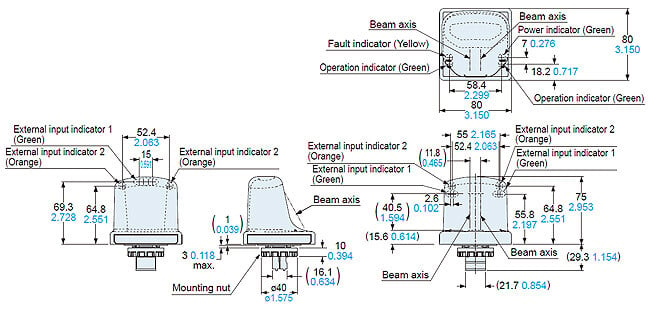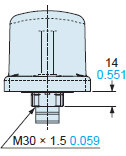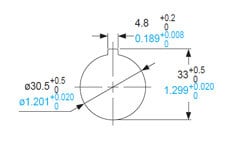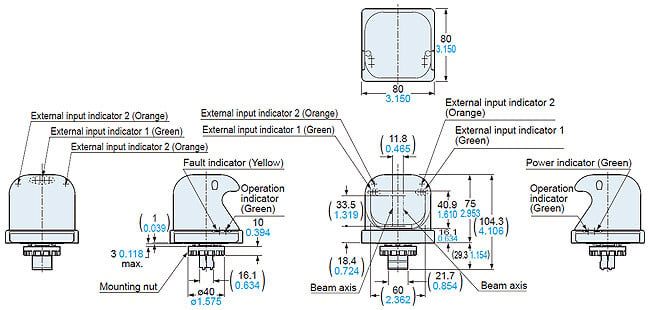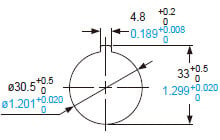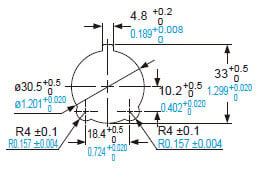| Sensing method | Thru-beam type photoelectric sensor (2 beam axes) |
|---|
| Applicable standards | CSA 22.2 No.14, CSA 22.2 No.0.8, ANSI / NFPA 79, UL 508, EN 60947-5-2 (EMC only) |
|---|
| Power supply | 12 to 24 V DC ±10 % Ripple P-P 10 % or less |
|---|
| Current consumption | 100 mA or less (excluding external connection load) |
|---|
| Outputs | Semiconductor Photo-MOS relay output x 3
• Maximum load current: 100 mA
• Applied voltage: 30 V DC or less (between output and +V)
• Residual voltage: 1.5 V or less (at 100 mA of load current) |
|---|
| | Output
operation | Output 1 : When an object is detected (beam is interrupted): OFF / When an object is not detected (beam is received): ON
Output 2, 3 : When an object is detected (beam is interrupted): ON / When an object is not detected (beam is received): OFF |
|---|
| Short-circuit protection | Incorporated |
|---|
| Response time | 100 ms or less when an object is detected, 50 ms or less when an object is not detected |
|---|
| Time-out function | Switchable either effective or ineffective by short-circuiting terminals (disabled when short-circuited) |
|---|
| External input | 0 to 1 V or 10 V to +V: Valid (External input indicator lights up), 4 to 6 V or Open: Invalid (External input indicator lights off) |
|---|
| Indicators | Power indicator
(POWER) | Green LED (lights up when the power is ON) |
|---|
Operation indicator
(OPE.) | Green LED (lights up when an object is detected) |
|---|
External input
indicator 1 | Green LED (lights up when external input 1 is valid) |
|---|
External input
indicator 2 | Orange LED (lights up when external input 2 is valid) |
|---|
Fault indicator
(FAULT) | Yellow LED (blinks or lights up when fault occurs) |
|---|
| Protection | IP65 (IEC), TYPE 1 (UL 50) (excluding terminal part) |
|---|
| Ambient temperature | −25 to +50 ℃ −13 to +122 ℉ (No dew condensation or icing allowed),
Storage: −30 to +70 ℃ −22 to +158 ℉ |
|---|
| Ambient humidity | 30 to 85 % RH, Storage: 30 to 85 % RH |
|---|
| Ambient illuminance | Incandescent light: 3,000 Lx or less at the light-receiving face |
|---|
| Voltage withstandability | 1,000 V AC for one min. between all supply terminals connected together and enclosure |
|---|
| Insulation resistance | 20 MΩ, or more, with 500 V DC megger between all supply terminals connected together and enclosure |
|---|
| Vibration resistance | 10 to 500 Hz frequency, 3 mm 0.118 in double amplitude in X, Y and Z directions for two hours each | 10 to 150 Hz frequency, 0.75 mm 0.030 in double amplitude in X, Y and Z directions for two hours each |
|---|
| Shock resistance | 500 m/s2 acceleration (50 G approx.) in X, Y and Z directions three times each |
|---|
Removable-type
terminals | Connector | 3.5 mm 0.138 in pitch, 2-level socket: 12 pins |
|---|
| Terminal part | 3.5 mm 0.138 in pitch spring-cage terminals: 6 pins x 2 (FMC1,5/6-ST-3,5GS manufactured by Phoenix Contact) |
|---|
| Cable | 0.2 to 1.5 mm2 [including single wire or ferrule (sleeve)] |
|---|
| Maximum cable length | Up to 20 m 65.617 ft (for cable from 0.2 to 0.3 mm2), Up to 100 m 328.084 ft (for cable from 0.3 to 1.5 mm2) |
|---|
| Material | Enclosure: Polycarbonate, Polyester, O-ring: Silicone rubber, Mounting nut: PBT, Mounting packing: Silicone rubber |
|---|
| Weight | Net weight: 130 g approx., Gross weight: 200 g approx. | Net weight: 150 g approx., Gross weight: 220 g approx. |
|---|





![Greater convenience with less stress on the hands. Inventive start-up switches in accordance with ergonomics. [SW-101]](https://ap.industry.panasonic.com/hubfs/pid-corp/products/fasys/sensor/safety/sw-101/images/pic02.jpg)
![Reduction in false operation from dropped objects [SW-101]](https://ap.industry.panasonic.com/hubfs/pid-corp/products/fasys/sensor/safety/sw-101/images/pic03.jpg)
![A switch that pursues the prevention requirement for malfunctioning as required by ISO 13851 (JIS B 9712) two-hand control devices [SW-111]](https://ap.industry.panasonic.com/hubfs/pid-corp/products/fasys/sensor/safety/sw-101/images/pic04.jpg)

![Intended startup is possible [SW-111]](https://ap.industry.panasonic.com/hubfs/pid-corp/products/fasys/sensor/safety/sw-101/images/pic06.jpg)





